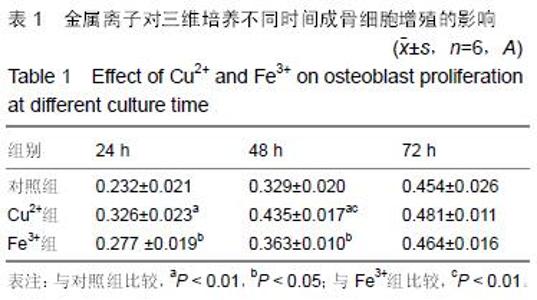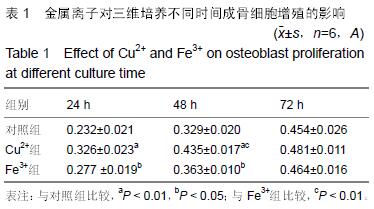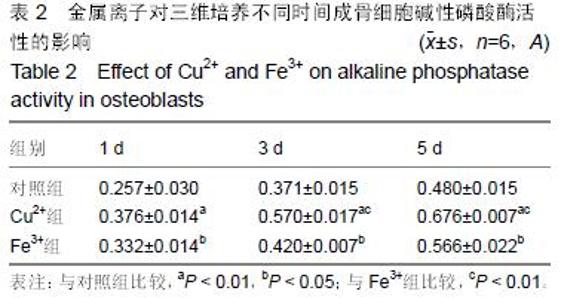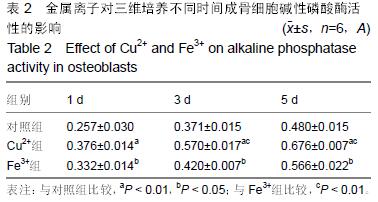Chinese Journal of Tissue Engineering Research ›› 2016, Vol. 20 ›› Issue (16): 2347-2353.doi: 10.3969/j.issn.2095-4344.2016.16.009
Previous Articles Next Articles
Effect of Cu2+ and Fe3+ on osteoblast growth and differentiation in hydrogel RADA16-NBD
Shi Jin-ming1, 2, Zhao Gang2, Ruan Qiang2
- 1Graduate School of Jiamusi University, Jiamusi 154002, Heilongjiang Province, China; 2Department of Orthodontics, Second Affiliated Hospital of Jiamusi University, Jiamusi 154002, Heilongjiang Province, China
-
Received:2016-02-14Online:2016-04-15Published:2016-04-15 -
Contact:Zhao Gang, Associate professor, Associate chief physician, Master’s supervisor, Department of Orthodontics, Second Affiliated Hospital of Jiamusi University, Jiamusi 154002, Heilongjiang Province, China -
About author:Shi Jin-ming, Studying for master’s degree, Graduate School of Jiamusi University, Jiamusi 154002, Heilongjiang Province, China -
Supported by:the Technological Innovation Project for Graduate in Jiamusi University, No. LZZ2014_027; the Natural Science Foundation of Heilongjiang Province, No. H201487
Cite this article
Shi Jin-ming, Zhao Gang, Ruan Qiang. Effect of Cu2+ and Fe3+ on osteoblast growth and differentiation in hydrogel RADA16-NBD[J]. Chinese Journal of Tissue Engineering Research, 2016, 20(16): 2347-2353.
share this article
| [1] Raisz LG.Mechamisms and regulation of bone resorption by osteoclastic cell. In:coe FL,Favus M.Disorder of bone and mineral metabolism, Connecticut:Raven Press, 1992:287. [2] Sudo H,Kodama HA,AmagaiY,et al.ln vitro differentiation andcalcification in a new Clonal osteogenic cell line derived fromnew born mouse calvaria.Cell Bio1.1983;96(1):191-198. [3] Mombeli A,Umurn R,Lang NP,et al.Actinobacilus actinomycetemcomitans in Chinese adults. Serotype distribution and analysis of the leukotoxin gene promoter Locus.J Clin Periodontl. 1999;26(8): 505 . [4] 潘德顺;陈伟强.葛根素对大鼠心肌缺血再灌注损伤的干预作用[J].中国老年学杂志,2010,30(3):332-334. [5] Weinberg E.Iron loading:a risk factor for osteoporosis.BioMetals.2009;19(6): 633-635. [6] Lai YL,Yamaguchi M.Effects of copper on bone component in the femoral tissues of rats: anaboliceffect of zinc is weakened by copper.Biol Pharm Bull.2005;28(12): 2296-2301. [7] Odabasi E,Turan M,Aydin A,et al.Magnesium, zinc, copper, manganese, and selenium levels in postmenopausal women with osteoporosis. can magnesium play a key role in osteoporosis.Ann Acad Med Singapore.2008;37:564-567. [8] Seo HJ,Cho YE,Kim T,et al.Zinc may increase bone formation through stimulating cell proliferation,alkaline phosphatase activity and collagen synthesis in osteoblastic MC3T3-E1 cells.Nutr Res Pract. 2010;4(5):356-361. [9] EI-Ayoubi R,Eliopoulos N,Diraddo R,et al.Design and fabrication of 3D porous scaffolds to facilitate cell-based gene therapy.Tissue Eng Part A. 2008; 14(6):1037-1048. [10] Nilsang S,Nehru V,Plieva FM,et al.Three- dimensional culture for monoclonal antibody production by hybridoma cells immobilized in macroporous gel particles.Biotechnol Prog. 2008; 24(5):1122-1131. [11] Bokhari MA,Akay G,Zhang S,et aLThe enhancement of osteoblast growth and differentiation in vitro on a peptide hydrogel- polyHIPE polymer hybrid material. Biomaterials. 2005;26(25): 5198-5208. [12] Zhang S,Holmes T,Lockshin C,et al.Spontaneous assembly of a self-complementary oligopeptide to form a stable macroscopic membrane.Proc Natl Acad Sci U S A. 1993;90(8):3334-3338. [13] Zhang S.Emerging biological materialsthrough molecular self-assembly. BiotechnolAdv. 2002;20(5-6): 321-339. [14] 张锋,任灵飞,应永芳,等.成骨细胞在精一丙一天一丙16自组装多肽水凝胶表面培养的研究[J].医学研究杂志, 2012,41(10):72-75. [15] Kisiday J,Jin M,Kurz B,et al.Self-assembling peptide hydrogel fosters chondrocyte extracellular matrix production and cell division:implications for cartilage tissue repair.Proc Natl Acad Sci USA. 2002;99(15): 9996-10001. [16] 李继斌,李辉,谢辉,等.脂联素诱导人成骨细胞的分化[J].中国组织工程研究与临床康复,2008,12(33):6406-6410. [17] 张冬燕,扈英伟.骨细胞对破骨细胞形成和功能的影响[J].中国骨质疏松杂志,2011,17(11):1066-1008. [18] Suda T, Nakamura I, Jimi E, et al.Regulation of osteoclast function.J Bone Min Res. 1997;12(6):869-879. [19] Teitelbaum SL.Bone resorption by osteocdasts. Science.2000;289(5484):1504-1508. [20] 安敏,安荣泽,王兆杰,等.骨细胞相关因子在骨重建中的作用[J].中国医学创新,2015,8(7):1674-4985. [21] Harada SI,Rodan GA,Control of osteoblast function and regulation of bone mass. Nature. 2003;423(6937): 349-355. [22] Kronenberg HM.Developmental regulation of the growth plate. Nature.2003;423(6937): 332-336. [23] Compston JE.Sex steroids and bone.Physiol Rev.2001; 81(1):419-447. [24] Feng X, McDonald JM.Disorders of bone remodeling. Ann Rev Pathol.2011;6:121. [25] 储诚兵,陈艺新,尹培荣,等.胰岛素样生长因子-1与成骨细胞 [J].中国矫形外科杂志,2001(3):275-277. [26] Bouillon R, Carmeliet G,Verlinden L, et al.Vitamin D and human health: lessons from vitamin Dreceptor null mice.Endocr Rev.2008;29(6):726-776. [27] 唐俊龙,王朝元,刘介,等.nHA/PCL复合材料组分配比对成骨细胞骨相关基因表达的影响研究[J].绿色科技, 2012, 50(5):277-279. [28] 袁斯远,孔蓓蓓,盛彤,等.葛根素干预小鼠成骨细胞分化相关特征性蛋白mRNA的表达[J].中国组织工程研究, 2014, 18(42):6732-6736. [29] Yamaguchi M,Goto M,Uchiyama S,et al.Effect of zinc on gene expression in osteoblastic MC3T3-E1 cells: enhancement of Runx2, OPG, and regucalcin mRNA expressions. Mol Cell Biochem.2008;312(1):157-166. [30] Kodama HA,Amagai Y,Sudo H,et aL.Establishment of a clonal osteogenic cell line from newborn mouse calvaria.J Oral Biol.1981;23:899. [31] Hata R,Hori H,Nagai Y,et aLSelective inhibition of type I collagen synthesis in Osteoblastic cells by epidermal growth factor. Endocrinology.1984;115(3):867-876. [32] Sudo H,Kodama HA,Amagai Y,et al.In vitro differentia- tion and calcification in a new clone osteogenic cell line de- reived from new bom mouse calvaria.J Cell Biol. 1983;96(1):191. [33] 赵刚,李京玲,王 丹,等.新型自组装水凝胶NBD/RADA16可促进前成骨细胞的分化[J].中国组织工程研究, 2014, 18(21):3329-3333. [34] 律方,薛奇.miR-614通过调控靶基因PSA表达抑制人肺癌细胞的侵袭和增殖能力[J].中国肺癌杂志, 2014, 17(10): 715-721. [35] Zhang JF,Lig,Chan CY,et al.Flavonoids of herba Epimedii regulate osteogenesis of human mesenchymal stem cells through BMP and Wnt/β-catenin signaling pathway.Mol Cell Endocrinol. 2010;314:70-74. [36] Woklarski KH.Properties and origin of osteoblasts.Clin Orthop Relat Res. 1990;(252):276-293. [37] Addison WN,Azari F,Sorensen ES,et al.Pyrophosphate inhibits mineralization of osteoblast cultures by binding to mineral, up-rgegulating osteopontin alkaline phosphatase activity.J Biol Chem. 2007;282(21): 15872-15883. [38] 林树忠,刘君.不同浓度葛根素对体外培养成骨细胞的影响[J].中国组织工程研究,2015,19(11):1658-1662. [39] 翟远坤,李志忠,陈克明,等.淫羊蕾苷对体外培养乳鼠颅骨成骨细胞增殖、分化及成熟的影响[J].中药材, 2011,34(6): 917-922. [40] 明磊国,陈克明,葛宝丰,等.淫羊藿苷与染料木黄酮对体外培养成骨细胞增殖及矿化成熟影响的对比研究[J].中国中药杂志,2011,36(16):2240-2245. |
| [1] | Li Cai, Zhao Ting, Tan Ge, Zheng Yulin, Zhang Ruonan, Wu Yan, Tang Junming. Platelet-derived growth factor-BB promotes proliferation, differentiation and migration of skeletal muscle myoblast [J]. Chinese Journal of Tissue Engineering Research, 2021, 25(7): 1050-1055. |
| [2] | Liu Cong, Liu Su. Molecular mechanism of miR-17-5p regulation of hypoxia inducible factor-1α mediated adipocyte differentiation and angiogenesis [J]. Chinese Journal of Tissue Engineering Research, 2021, 25(7): 1069-1074. |
| [3] | Ma Zetao, Zeng Hui, Wang Deli, Weng Jian, Feng Song. MicroRNA-138-5p regulates chondrocyte proliferation and autophagy [J]. Chinese Journal of Tissue Engineering Research, 2021, 25(5): 674-678. |
| [4] | Wang Yujiao, Liu Dan, Sun Song, Sun Yong. Biphasic calcium phosphate loaded with advanced platelet rich fibrin can promote the activity of rabbit bone marrow mesenchymal stem cells [J]. Chinese Journal of Tissue Engineering Research, 2021, 25(4): 504-509. |
| [5] | Zhou Jihui, Yao Meng, Wang Yansong, Li Xinzhi, Zhou You, Huang Wei, Chen Wenyao. Influence of novel nanoscaffolds on biological behaviors of neural stem cells and the related gene expression [J]. Chinese Journal of Tissue Engineering Research, 2021, 25(4): 532-536. |
| [6] | Chen Yang, Huang Denggao, Gao Yuanhui, Wang Shunlan, Cao Hui, Zheng Linlin, He Haowei, Luo Siqin, Xiao Jingchuan, Zhang Yingai, Zhang Shufang. Low-intensity pulsed ultrasound promotes the proliferation and adhesion of human adipose-derived mesenchymal stem cells [J]. Chinese Journal of Tissue Engineering Research, 2021, 25(25): 3949-3955. |
| [7] | Zhou Wu, Wang Binping, Wang Yawen, Cheng Yanan, Huang Xieshan. Transforming growth factor beta combined with bone morphogenetic protein-2 induces the proliferation and differentiation of mouse MC3T3-E1 cells [J]. Chinese Journal of Tissue Engineering Research, 2021, 25(23): 3630-3635. |
| [8] | Huo Hua, Cheng Yuting, Zhou Qian, Qi Yuhan, Wu Chao, Shi Qianhui, Yang Tongjing, Liao Jian, Hong Wei. Effects of drug coating on implant surface on the osseointegration [J]. Chinese Journal of Tissue Engineering Research, 2021, 25(22): 3558-3564. |
| [9] | Yu Chengshuai, Du Gang, Pang Shenning, Lao Shan. Chemerin, a pro-inflammatory adipokine, regulates chondrocyte proliferation and metabolism by increasing production of nitric oxide [J]. Chinese Journal of Tissue Engineering Research, 2021, 25(2): 258-263. |
| [10] | Wei Qin, Zhang Xue, Ma Lei, Li Zhiqiang, Shou Xi, Duan Mingjun, Wu Shuo, Jia Qiyu, Ma Chuang. Platelet-derived growth factor-BB induces the differentiation of rat bone marrow mesenchymal stem cells into osteoblasts [J]. Chinese Journal of Tissue Engineering Research, 2021, 25(19): 2953-2957. |
| [11] | Guo Zhibin, Wu Chunfang, Liu Zihong, Zhang Yuying, Chi Bojing, Wang Bao, Ma Chao, Zhang Guobin, Tian Faming. Simvastatin stimulates osteogenic differentiation of bone marrow mesenchymal stem cells [J]. Chinese Journal of Tissue Engineering Research, 2021, 25(19): 2963-2968. |
| [12] | Dai Yaling, Chen Lewen, He Xiaojun, Lin Huawei, Jia Weiwei, Chen Lidian, Tao Jing, Liu Weilin. Construction of miR-146b overexpression lentiviral vector and the effect on the proliferation of hippocampal neural stem cells [J]. Chinese Journal of Tissue Engineering Research, 2021, 25(19): 3024-3030. |
| [13] | Ailimaierdan·Ainiwaer, Wang Ling, Gu Li, Dilidaer•Taxifulati, Wang Shan, Yin Hongbin. Effect of transforming growth factor-beta3 on the proliferation and osteogenic capability of osteoblasts [J]. Chinese Journal of Tissue Engineering Research, 2021, 25(17): 2664-2669. |
| [14] | Wang Renxian, Cao Jingjing, Wang Honggang, Wan Ben, Liu Weifeng. Effects of dispersants on aggregation, intracellular distribution and cell proliferation of nano-hydroxyapatite [J]. Chinese Journal of Tissue Engineering Research, 2021, 25(16): 2500-2505. |
| [15] | Wu Yukun, Han Jie, Wen Shuaibo. Mechanism of Runx2 gene in fracture healing [J]. Chinese Journal of Tissue Engineering Research, 2021, 25(14): 2274-2279. |
| Viewed | ||||||
|
Full text |
|
|||||
|
Abstract |
|
|||||





